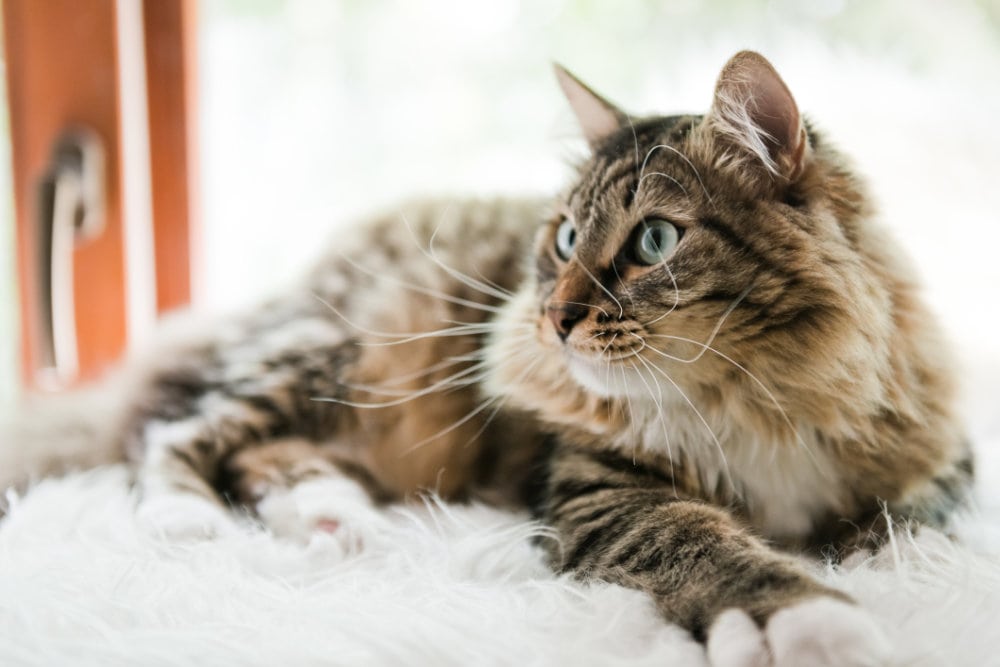How to treat hairballs in cats?
How to treat hairballs in cats?
Cats are creatures that are extremely fond of cleanliness – they spend around ⅓ of their time on licking their coat. A “side effect” of these activities is swallowed hair which may deposit in the gastrointestinal tract. How to get rid of it effectively and safely?
Licking the fur causes a large number of hairs to enter the cat’s gastrointestinal tract. This is especially true for long-haired cats, but hairballs can also form in the tract of cats with short hair, especially during moulting.

How do hairballs form?
Pilobezoars, which are balls made of clamp hair, are formed in a cat’s stomach. While cleaning, the cat licks its coat with a rough tongue. Hair gets caught in the hooks on the tongue. The cat is not able to spit it out and swallows it. In the stomach, the hairs form balls. In healthy short-haired cats, hair usually passes through the gastrointestinal tract and is excreted with faeces. To get rid of excess hair, cats instinctively try to induce a vomiting reflex by eating grass. However, if there is too much hair or the cat does not have a healthy digestive tract, the balls are becoming more and more difficult to excrete. If they remain in the stomach, they irritate its mucous membrane and may cause inflammation, catarrh and gastric ulcers. If the balls continue to stay in the intestines, they can lead to motility disorders, faecalith and bowel obstruction. In the worst case, pilobezoars can clog the gastrointestinal tract. This is a life-threatening condition.
Symptoms of hairballs
If your cat has problems excreting hair that has accumulated in the digestive tract, it may experience the following symptoms:
- frequent vomiting (usually the cat vomits a moment after giving it water or food),
- constipation,
- loss of appetite,
- dry coughing, choking,
- weight loss,
- malaise, apathy.
If your cat’s constipation persists for several days, a vet appointment is necessary.
How to successfully treat hairballs in cats?
If your cat has trouble removing its hair naturally, you should help. One of the ways is to plant the so-called cat grass, which is one of the varieties of papyrus (Cyperus alternifolius species). You can also sow barley or oats that have a softer blade than papyrus and are more suitable for cats with sensitive stomachs. Plucking the grass will cause your cat to vomit so it can get rid of any hair in its stomach. At the same time, providing your cat with its own “grazing” garden can protect our potted plants from animals tempted by the greenery. Remember not to keep at home the plants which are toxic for your cat.
Another way to remove hair is to make it easier for your cat to pass it through the gastrointestinal tract. Preparations containing malt are best suited for this purpose as it is not digested by the cat’s digestive tract, but stimulates the intestinal passage. It improves intestinal peristalsis, lubricates digestive tract walls and allows the cat to excrete hair before it clamps into hard, tough-to-remove balls. The preparation for hairballs can be in the form of a paste, such as dr Seidel Malt paste. Short-haired cats should receive 3–4 cm of this paste daily, while long-haired cats – about 6 cm. If the first symptoms of hairballs occur, the dose can be increased three times. The paste can be fed directly from the tube or mixed with food.
Pets which are not fond of paste will certainly be eager to try dr Seidel Malt anti-hairball treats for cats. It is the first treat available on the market enriched with malt and taurine, which stimulates the proper functioning of the heart, eyesight and nervous system, in quantities corresponding to dietary supplements. The dosage is 10 treats a day.
Where these methods fail, the intervention of a veterinarian is necessary.
How do I prevent the hairballs from forming?
To prevent the cat suffering from hairballs, it is advisable to use prophylaxis by regularly administering anti-hairball products (at a dose consistent with the manufacturer’s recommendations) and regularly brushing your pet, especially during moulting, when the risk of hairballs is higher. Long-haired cats should be combed every day, while semi-longhaired cats several times a week.
4 October 2018


